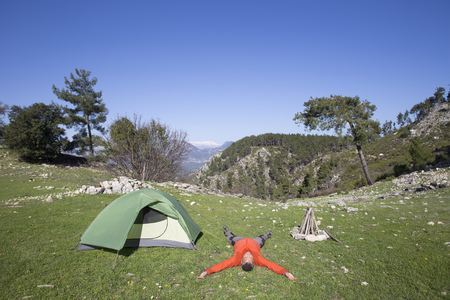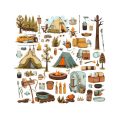1. Understanding the Leave No Trace Ethic
When it comes to camping sustainably in the U.S., one of the most important things you can do is follow the Leave No Trace (LNT) principles. These seven guidelines help outdoor enthusiasts reduce their impact on nature, so future generations can enjoy it too. But before diving into the specifics, its helpful to understand where these principles come from and why they matter so much in American outdoor culture.
Origins of Leave No Trace
The Leave No Trace ethic was developed in the 1960s and 70s as more Americans began exploring public lands like national parks, forests, and wilderness areas. The increased foot traffic started to leave visible impacts—trampled vegetation, litter, damaged trails, and polluted water sources. In response, organizations like the U.S. Forest Service, National Park Service, and Bureau of Land Management teamed up with outdoor groups to create a set of simple yet powerful guidelines that would help people enjoy nature responsibly.
By the 1990s, the nonprofit Leave No Trace Center for Outdoor Ethics was established to educate the public and promote sustainable outdoor practices nationwide.
Why It Matters in American Outdoor Culture
Outdoor recreation is a huge part of American life. Whether its weekend car camping at a state park or backpacking deep into a national forest, millions of people head outside each year to relax, recharge, and connect with nature. With such high usage comes a big responsibility: taking care of the land so it stays clean and wild for everyone.
This is where the LNT ethic really shines. Its not about being perfect—its about making better choices while youre out there. The idea is simple: leave places as good or better than you found them. That mindset has become part of the outdoor culture in the U.S., especially among campers, hikers, and backpackers who value preserving natural beauty and wilderness experiences.
The Seven Principles at a Glance
| Principle | Main Idea |
|---|---|
| 1. Plan Ahead and Prepare | Avoid unexpected problems by researching your destination and packing smartly. |
| 2. Travel and Camp on Durable Surfaces | Stick to established trails and campsites to prevent erosion and damage. |
| 3. Dispose of Waste Properly | “Pack it in, pack it out” — take all trash with you, including food scraps. |
| 4. Leave What You Find | Dont pick plants or take souvenirs; let others enjoy them too. |
| 5. Minimize Campfire Impact | If fires are allowed, keep them small or use a camp stove instead. |
| 6. Respect Wildlife | Observe animals from a distance and never feed them. |
| 7. Be Considerate of Other Visitors | Keep noise down and yield to others on trails for a friendly experience. |
A Shared Responsibility
No matter your experience level or how often you go camping, practicing Leave No Trace is something everyone can do. It’s about showing respect—for the land, for wildlife, and for other people who love spending time outdoors just like you do. By understanding the roots of this ethic and embracing its values, youre helping protect Americas wild spaces now and into the future.
2. Planning Ahead for Low-Impact Camping
One of the best ways to camp sustainably is by planning ahead. Good preparation not only helps you stay safe and comfortable, but it also reduces your impact on the environment. Whether youre heading into a national park or pitching a tent in your local forest, thoughtful planning makes a big difference.
Choose Eco-Friendly Gear
Start by selecting gear that’s durable, reusable, and made from sustainable materials. Avoid single-use plastics and opt for products that are built to last. Heres a quick comparison:
| Item | Sustainable Option | Avoid |
|---|---|---|
| Water Bottle | Stainless steel or BPA-free reusable bottle | Disposable plastic bottles |
| Utensils | Bamboo or metal camping utensils | Plastic cutlery |
| Tent | High-quality, long-lasting tent with repair options | Cheap, single-use pop-up tents |
Research Local Regulations and Guidelines
Every environment has its own rules and sensitivities. Before you go, check the official website of the area youll be visiting. Look for information about fire restrictions, camping zones, wildlife precautions, and waste disposal rules. Following local guidelines shows respect for the land and helps preserve it for future visitors.
Questions to Ask Before You Go:
- Do I need a permit to camp here?
- Are campfires allowed?
- What are the rules for food storage?
- Where can I dispose of trash or human waste?
- Are there any seasonal closures or endangered species in the area?
Understand the Terrain and Weather Conditions
Packing appropriate clothing and gear based on terrain and weather reduces the chances of needing emergency assistance, which can stress natural resources. For example, wearing proper footwear prevents trail damage caused by going off-path to avoid mud or puddles.
Quick Prep Checklist:
- Download maps for offline use (cell service may be limited)
- Check weather forecasts and pack accordingly
- Plan meals to avoid excess packaging and food waste
- Bring trash bags to pack out everything you bring in
Plan Your Route with Minimal Impact in Mind
Select established trails and campsites whenever possible. Avoid creating new paths or disturbing vegetation. If youre heading into a less-developed area, learn how to identify durable surfaces like rock or gravel where camping will cause less damage.
Sustainable Navigation Tips:
- Avoid traveling during wet conditions to prevent erosion
- Campsite at least 200 feet away from lakes and streams
- If hiking off-trail, spread out to minimize repeated trampling in one spot
A little planning goes a long way toward protecting nature. By preparing ahead with sustainability in mind, you help ensure that wild places stay wild—for yourself and everyone else who loves the outdoors.

3. Choosing the Right Campsite
Selecting the right campsite is one of the most important steps in camping sustainably. Whether youre setting up in a backcountry area or a developed campground, your choices can have a lasting impact on the environment. By following Leave No Trace principles, you help protect natural spaces for future generations while still enjoying your outdoor adventure.
Backcountry Camping: Stay Off the Beaten Path
When camping in undeveloped or wilderness areas, it’s essential to choose a site that preserves the natural landscape:
- Camp at least 200 feet away from lakes, rivers, and trails to avoid disturbing wildlife and water sources.
- Use existing campsites when available. Look for flat, durable surfaces like rock, gravel, or dry grass.
- Avoid fragile environments such as wetlands, alpine meadows, or cryptobiotic soil (common in desert regions).
Durable Surfaces Guide
| Surface Type | Sustainability Rating | Description |
|---|---|---|
| Rock & Gravel | ★★★★★ | Highly durable and low-impact; ideal for tents and foot traffic. |
| Dry Grass | ★★★★☆ | A good option if vegetation is minimal and already flattened. |
| Pine Needles & Forest Floor | ★★★☆☆ | Adequate for short stays; avoid compacting live plant matter. |
| Moss & Wetlands | ★☆☆☆☆ | Easily damaged; avoid camping here entirely. |
Established Campgrounds: Respect Designated Areas
If youre staying in a managed campground, sustainability means using facilities as intended:
- Set up only in designated tent pads or sites.
- Avoid expanding your footprint. Don’t move rocks or logs unnecessarily or clear new space.
- Stick to roads and trails. Cutting across vegetation leads to erosion and habitat damage.
Sustainable Tips for Developed Sites
- Avoid hanging hammocks on sensitive trees—use straps that won’t damage bark.
- If fires are allowed, use established fire rings and keep fires small.
No matter where you camp, the key is minimizing your impact by choosing spots that require little to no alteration of the natural environment. Always remember: the best campsite is one that looks like no one ever stayed there.
4. Managing Waste the Right Way
Keeping our campsites clean isnt just about comfort—its about protecting nature and making sure everyone can enjoy the outdoors. When we manage waste properly, we help preserve trails, rivers, forests, and wildlife habitats for future campers. Heres how to handle trash, human waste, and food scraps the right way.
Trash: Pack It In, Pack It Out
Whatever you bring with you should leave with you. That means every wrapper, bottle cap, and piece of micro-trash. Even biodegradable items like orange peels or sunflower seed shells can take years to break down and arent native to most environments.
Best Practices for Trash Disposal:
| Do | Dont |
|---|---|
| Bring reusable containers to reduce packaging waste | Leave trash in fire pits or bury it |
| Use a designated trash bag thats durable and sealable | Burn your garbage (it pollutes air and may not fully burn) |
| Check your campsite for micro-trash before leaving | Assume someone else will clean up after you |
Human Waste: Go Before You Go—or Know Where to Go
If youre camping at a site with bathrooms—great! Use them. But in backcountry areas without facilities, its important to dispose of human waste in a way that doesnt harm water sources or other campers experiences.
Two Main Options:
- Catholes: Dig a hole 6-8 inches deep at least 200 feet away from water sources, trails, and camp. After use, cover it with soil and natural materials.
- Packed-Out Systems: Some areas require campers to pack out their waste using portable toilet systems or “wag bags.” Always check local regulations.
Toilet Paper Tips:
- Use plain, unscented toilet paper
- Pack it out in a sealed bag if possible
- If burying is allowed, make sure its deep enough so animals won’t dig it up
Food Scraps: Not Just “Natural” Trash
Leftover food might seem harmless, but it can attract wildlife and disrupt their natural diet. Animals that get used to human food can become aggressive or dependent on campsites for meals.
Smart Food Waste Habits:
- Avoid overpacking perishable foods—plan meals carefully
- Strain dishwater through a mesh screen and pack out food particles
- Store all food waste securely until you can dispose of it properly off-site
- Never feed wildlife—even accidentally through crumbs or scraps left behind
Caring for nature starts with the small stuff—literally. By managing our waste responsibly while camping, we help keep America’s wild places beautiful, healthy, and safe for generations to come.
5. Respecting Wildlife and Natural Resources
When youre out camping, one of the best parts is seeing wildlife in its natural habitat. But its important to do so in a way that keeps animals safe and protects their environment. Respecting wildlife and natural resources is key to sustainable camping and follows the Leave No Trace principles.
Observe Animals from a Distance
Getting too close to wild animals can stress them out or even change their natural behavior. Use binoculars or a camera with zoom if you want a closer look. Keep quiet, move slowly, and never try to touch, feed, or chase any animal. This keeps both you and the animal safe.
Safe Wildlife Viewing Tips
| Do | Dont |
|---|---|
| Use binoculars for viewing | Approach animals directly |
| Stay on trails | Make loud noises near habitats |
| Store food securely | Feed wildlife |
Avoid Disrupting Ecosystems
Even small actions can damage delicate ecosystems. Stick to established trails and campsites to avoid trampling plants or disturbing nesting areas. Avoid picking flowers, moving rocks, or collecting natural items like feathers or shells — these all play a role in the environments balance.
Minimize Impact on Sensitive Habitats
Certain areas like wetlands, alpine zones, and desert crusts are especially fragile. Camp at least 200 feet away from water sources to protect aquatic life and prevent erosion. Set up your tent on durable surfaces like gravel, dry grass, or designated pads.
Best Practices for Different Environments
| Environment | Sustainable Camping Tip |
|---|---|
| Forests | Avoid damaging tree roots; use hammock straps that won’t cut bark |
| Deserts | Stay on marked paths to protect fragile soil crusts |
| Mountains/Alpine Zones | Camp below tree line when possible to reduce exposure and impact |
By keeping wildlife safe and protecting natural resources, youre helping ensure these places stay wild and beautiful for future campers to enjoy.
6. Leaving it Better Than You Found It
One of the most powerful ways to camp sustainably is by going the extra mile to improve the environment youre visiting. Its more than just cleaning up after yourself—its about becoming a steward of the land and inspiring others to do the same. This principle goes beyond “Leave No Trace” and leans into “Leave it Better.”
Restore Impacted Areas
Sometimes you’ll come across campsites or trails that have been damaged by overuse or careless visitors. If its safe and appropriate, take some time to help restore these areas. That could mean picking up trash, dismantling illegal fire rings, or brushing over social trails (unofficial paths created by foot traffic).
Simple Ways to Restore Campsites
| Action | Impact |
|---|---|
| Pack out litter (even if its not yours) | Keeps wildlife safe and the area clean for others |
| Dismantle unauthorized fire rings | Reduces fire risk and discourages future misuse |
| Cover up social trails with natural materials | Helps restore vegetation and reduce erosion |
| Replant native species (if allowed) | Supports local ecosystems and biodiversity |
Share Conservation Knowledge
Talking about sustainable camping doesn’t need to be preachy. Whether youre chatting around a campfire or posting on social media, share tips and stories that highlight good practices. Teaching others how to minimize their impact can spark a ripple effect of responsible outdoor behavior.
Ideas for Sharing Knowledge:
- Lead by example when camping with friends or family
- Create simple how-to videos or blog posts about Leave No Trace tips
- Mention eco-friendly gear choices when talking about your camping setup
- Encourage kids to participate in cleanup efforts—it’s fun and educational!
Encourage Others to Join In
Sustainable camping becomes even more effective when it’s a community effort. Invite your fellow campers to join cleanup hikes or participate in trail maintenance days. The more people feel connected to nature, the more likely they are to protect it.
Ways to Get Others Involved:
- Organize group cleanups at popular campsites or along hiking trails
- Partner with local outdoor organizations for conservation events
- Offer carpooling options to reduce carbon emissions on trips
- Create a friendly “pack it out” challenge during your camping trip
Caring for the outdoors isnt just something we do while were there—it’s a mindset we carry with us everywhere we go. By restoring what’s been damaged, sharing what we know, and encouraging our community, we make sure these beautiful places stay wild and welcoming for everyone.


